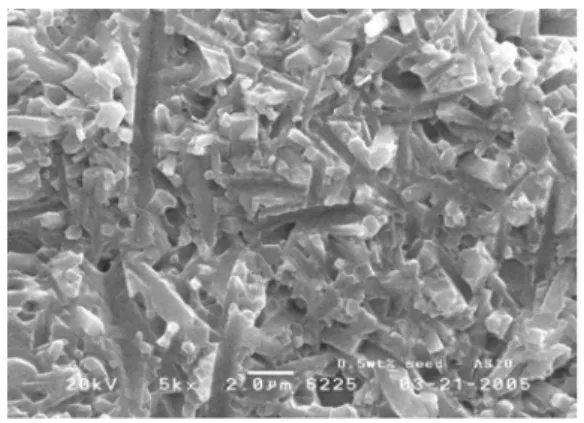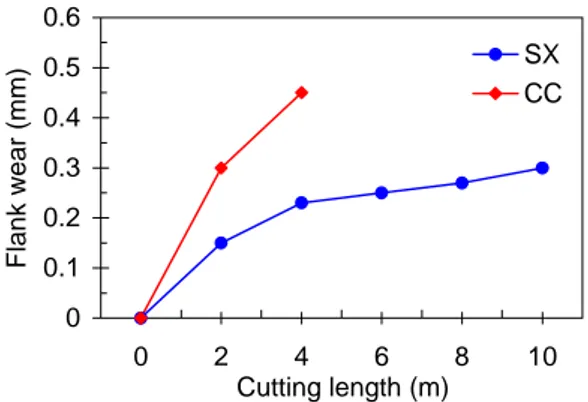© Korean Powder Metallurgy Institute 861
-1. Introduction
Silicon nitride based ceramic cutting tool is widely being used for the machining of cast irons and especially good for turning of gray cast iron material. It is the most popular cutting tool material for turning of brake discs in automotives and has more than 2 times longer tool life when compared to conventional coated cemented carbide tool grades. It is capable of much higher cutting speed machining, so can achive higher productivity than carbide tools.
However, the usage of silicon nitride based tool is limited due to unexpected short tool life. It reacts often with workpiece material during high speed continuous machining and is apt to break for small themal or mechanical shock because of its low physical properties. Furthermore the material of automotive parts are getting harder and tougher, therefore the tool life is getting shorter and shorter, especially is very short in compacted graphite iron [1].
Generally cast iron is divided into 3 groups by the shape of graphite in the matrix, i.e., gray, nodular and compacted graphite iron (CGI). CGI has higher hardness and also higher tensile strength [2] than gray cast iron, so its application is increasing in the manufacturing of cylinder block of diesel engine in the field of automotive industry.
In this paper, an attempt has been made to study the effect of various factors that will improve the physical properties in silicon nitride ceramics. And also a comparision study was made for the cutting performance of new silicon nitride ceramics with conventional silicon nitride and coated cemented carbide cutting tools in high speed milling of compacted graphite iron workpiece.
2. Experimental and Results
The starting materials used were Si3N4 (SN-E10, Ube
Industries Co., Japan), Al2O3 (AKP30, Sumitomo Chemical Co., Japan), Y2O3 (Grade C, H.C. Starck, Germany). The chemical compositions of cutting tool were 92.0 wt% Si3N4, 2.5 wt% Al2O3, 5.5 wt% Y2O3.
The specimens were prepared by heating to 1700oC under 1 bar pressure of nitrogen gas, and then gas pressure sintered from 1700 oC to 1800 oC under 100 bar N
2 gas and held at 1800 oC for 1hr.
The microstructures of sintered samples were observed using SEM. Basic physical properties were also measured for density, hardness and fracture toughness. The typical microstructure of specimen for machining tests was shown in Fig. 1.
Fig. 1. SEM micrographs of Si3N4 specimen with high
fracture toughness.
Cutting conditions were as follows, cutting speed 400-1,000m/min, feed rate 0.1-0.2mm/th, depth of cut 2mm, without coolant. Workpiece materials were gray cast iron and compacted graphite iron. The cutting performances of these specimens were compared to coated cemented carbides and conventional silicon nitride grades.
2006 POWDER METALLURGY World Congress
C05-03-3
High Toughness Silicon Nitride Material in Machining of Compacted Graphite Iron
Kwon-Hee Parka, Kern-Woo Leeb, Joo-Wan Leec, and Moshe Sharond
Taegutec Ltd., 304 Yonggye-Ri, Gachang-myeon, Dalsung-gun, Daegu 711-860, Korea a
khpark@taegutec.co.kr, bkwl@taegutec.co.kr, cjwl@taegutec.co.kr, dm.sharon@taegutec.co.kr Abstract
The suitable tools for CGI material has not been developed yet because of high hardness, high toughness and very low machininability compared to the grey cast iron. And the tool life has been decreased as the contents of Ti in CGI material. From this research, we were able to do the high speed machining by using high toughness silicon nitride ceramic tools. The silicon nitride ceramic tool grade was specially designed and prepared with microstructure of elongated grains with higher aspect ratio (c/a) than conventional one.
© Korean Powder Metallurgy Institute 862 -Flank wear of this silicon nitride cutting tool, SX compared to coated carbide was shown in Fig. 2. It is observed that the tool life of SX was much longer than CC.
Fig. 2. Flank wear of cutting tools during machining for compacted graphite iron (CGI-0.03%Ti). SX : Silicon nitride, CC : Coated carbide.
3. Summary
Specially prepared high toughness silicon nitride ceramics is very good grade for high speed milling of compated graphite iron and conventional gray cast iron. It is capable of milling cutting speed to 1,500m/min without losing tool life. It gives around 5 times higher productivity and also longer tool life than coated carbide cutting tools.
4. References
1. K.H.Park, K.W.Lee, J.W.Lee and M.Sharon, 7. Machining Workshop 2004, November 11-12 2004 Darmstadt, Germany
2. K.H.Park, K.W.Lee, J.W.Lee and M.Sharon, 3rd International Seminar on Machining Technologies, July 15-16 2005 Nimhans Convention Center, Bangalore, India.
3. S.M.Lee, K.H.Park, J.W.Yoo and H.T.Kim, Key Engineering Materials Vol. 287 (March 2005) pp. 253-258 0 0.1 0.2 0.3 0.4 0.5 0.6 0 2 4 6 8 10 Cutting length (m) Flank wear (mm) SX CC

